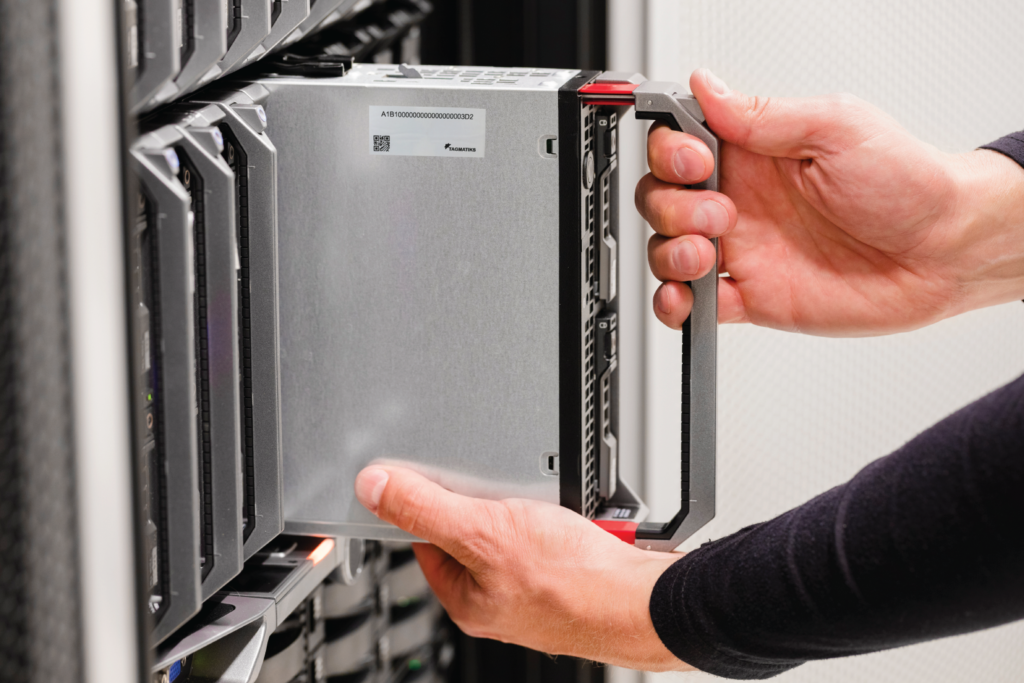Given that every data center houses the computing infrastructure necessary for IT systems, such as servers, data storage drives, switches, routers, and various other network equipment, along with the management of digital data from different companies, it is crucial to handle the assets in the data center promptly and efficiently.

Keeping track of data center assets by hand takes effort and is prone to mistakes. Network equipment and computers are frequently arranged densely in data centers. Manual counting of these assets or individually scanning all the serial numbers of these assets are always a tedious task and can lead to errors.
RFID technology ensures precise and current information on the whereabouts of assets by scanning and tracking them autonomously. By optimizing stock levels and minimizing inconsistencies, these computerized inventory counts help avoid problems like loss and overstocking.
RFID is becoming a popular option and extensively used in data centers for asset tracking given its efficiency and accuracy. Here are a few benefits which RFID technology provides to data centers to help track assets.
Automated Inventory:
RFID technology enables automated inventory tracking. Data center staff can use RFID Tags on the assets and quickly conduct asset audits by using RAIN RFID handheld readers . This automation reduces the time and effort required for manual asset tracking.
TagMatiks AT is a prominent inventory software and has proven its ability for a long time and can be implemented easily for inventory at any data center.

Security:
Equipment misplacement can be a problem, particularly when a server or any asset is relocated to a new rack or the new area without the system being updated. Monitoring and accounting for the numerous, frequently vital, and highly valued assets found in data centers is crucial. RFID technology makes it simple to detect assets by using RFID handheld readers to locate the misplaced assets. Not only does this save man-hours, but also secure your assets.
Smooth Workflow:
RFID handheld allows you to quickly reconcile a whole rack of servers by applying RFID tags to each asset. Because RFID readers can read many tags at once, you can see exactly the count of all your assets, what is missing and what is accounted for right away. By automating procedures like equipment check-in, check-out, transferring or scheduled maintenance of the asset, RFID helps to simplify workflow processes. This lowers the possibility of human error related to manual data entry and improves operational efficiency.
Cutdown Downtime:
RFID allows you to scan thousands of tags in a few seconds and can provide real-time data but also enables you to maintain warranty details, schedule maintenance, service history, and other other crucial asset information. You can maintain your assets and always be ready for any proactive approach whenever any risk or failure occurs. This actually reduces the time spent on manual tracking, and minimizes the risk of human errors and saves a lot of time that can be utilized on the other task.
Scalability:
Passive RFID tags not only come in various forms, shapes and differently designed for different assets but also very cost-effective and suitable for tracking the assets. RFID technology can adjust to the changing environment, integrate with existing software systems and can be easily expanded as additional assets are added to a data center.
The TagMatiks AT enterprise version is cloud based and includes a variety of out of the box features. TagMatiks AT improves the asset tracking process and eliminates the manual entry errors using RFID or Barcode technologies. It keeps track of the full life cycle (Receiving to Consumed / Disposed) of your assets including scheduled maintenance or repair.
Data Analytics:
Collected data and reports generated from any software always plays an important role to evaluate and help improve the process. If historical data analysis provides you the trend and patterns, operational data analysis provides you the insight of the movement of the assets.
RFID technology helps you generate various reports and analytics to aid you in resource allocation, equipment upgrades and can be analyzed to gain insights into asset utilization, predictive maintenance needs, and optimize resource allocation within the data center.

Getting Started:
The long-term advantages of data center asset tracking systems are the evident that you’ll be able to maximize your available space and increase your productivity. By implementing RFID, it’s assuring to know that your data center equipment is more accurate, productive and secure.
To start with RFID Asset Tracking Software, TagMatiks AT Lite is not only a cost effective solution but requires less infrastructure and can build a lot more confidence in the technology. The solution has extensive options when it comes to RAIN RFID (UHF) handhelds and sleds that are supported.
A free version of this software is available and can be downloaded directly from the iOS App Store or Android Play Store or by searching TagMatiks AT Lite. The Windows Version of TagMatiks AT Lite can also be downloaded.
At any point of time, all the assets from TagMatiks AT Lite can be migrated to the enterprise version of TagMatiks AT which is highly configurable and with countless out of the box reports and can help make better business decisions with real data.
Conclusion:
As data centers continue to evolve, RFID remains an indispensable technology ensuring optimal efficiency and security in the management of valuable assets.